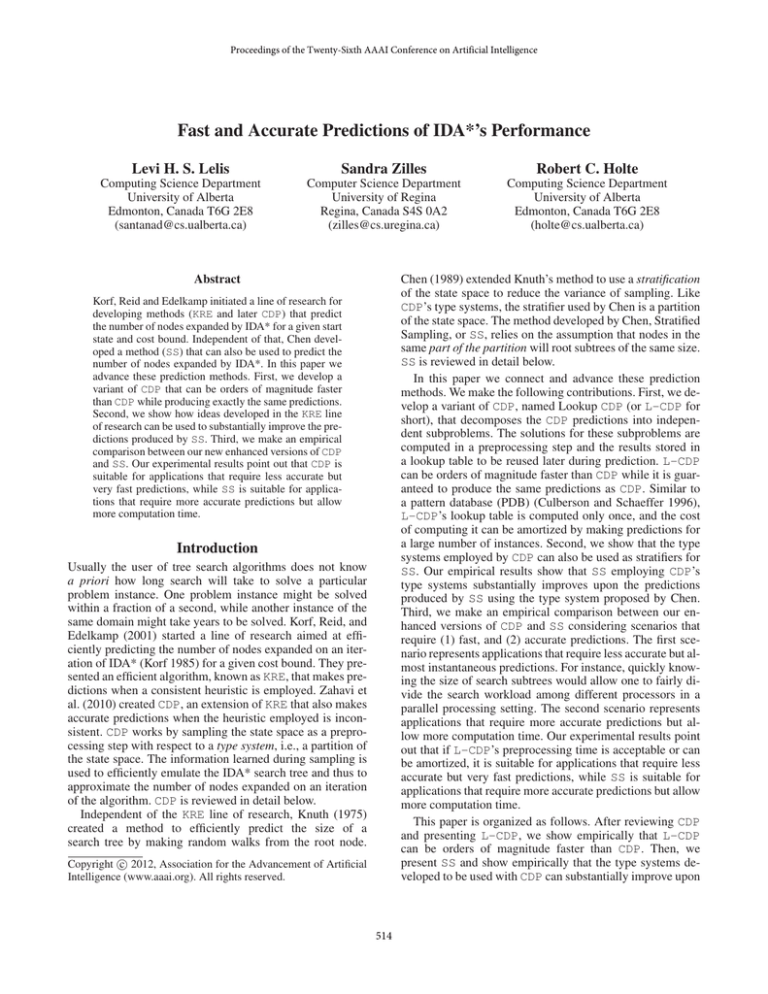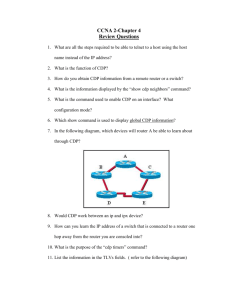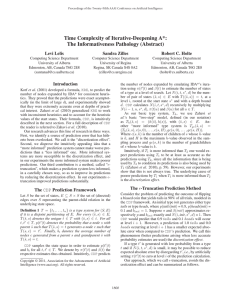
Proceedings of the Twenty-Sixth AAAI Conference on Artificial Intelligence
Fast and Accurate Predictions of IDA*’s Performance
Levi H. S. Lelis
Sandra Zilles
Robert C. Holte
Computing Science Department
University of Alberta
Edmonton, Canada T6G 2E8
(santanad@cs.ualberta.ca)
Computer Science Department
University of Regina
Regina, Canada S4S 0A2
(zilles@cs.uregina.ca)
Computing Science Department
University of Alberta
Edmonton, Canada T6G 2E8
(holte@cs.ualberta.ca)
Abstract
Chen (1989) extended Knuth’s method to use a stratification
of the state space to reduce the variance of sampling. Like
CDP’s type systems, the stratifier used by Chen is a partition
of the state space. The method developed by Chen, Stratified
Sampling, or SS, relies on the assumption that nodes in the
same part of the partition will root subtrees of the same size.
SS is reviewed in detail below.
In this paper we connect and advance these prediction
methods. We make the following contributions. First, we develop a variant of CDP, named Lookup CDP (or L-CDP for
short), that decomposes the CDP predictions into independent subproblems. The solutions for these subproblems are
computed in a preprocessing step and the results stored in
a lookup table to be reused later during prediction. L-CDP
can be orders of magnitude faster than CDP while it is guaranteed to produce the same predictions as CDP. Similar to
a pattern database (PDB) (Culberson and Schaeffer 1996),
L-CDP’s lookup table is computed only once, and the cost
of computing it can be amortized by making predictions for
a large number of instances. Second, we show that the type
systems employed by CDP can also be used as stratifiers for
SS. Our empirical results show that SS employing CDP’s
type systems substantially improves upon the predictions
produced by SS using the type system proposed by Chen.
Third, we make an empirical comparison between our enhanced versions of CDP and SS considering scenarios that
require (1) fast, and (2) accurate predictions. The first scenario represents applications that require less accurate but almost instantaneous predictions. For instance, quickly knowing the size of search subtrees would allow one to fairly divide the search workload among different processors in a
parallel processing setting. The second scenario represents
applications that require more accurate predictions but allow more computation time. Our experimental results point
out that if L-CDP’s preprocessing time is acceptable or can
be amortized, it is suitable for applications that require less
accurate but very fast predictions, while SS is suitable for
applications that require more accurate predictions but allow
more computation time.
This paper is organized as follows. After reviewing CDP
and presenting L-CDP, we show empirically that L-CDP
can be orders of magnitude faster than CDP. Then, we
present SS and show empirically that the type systems developed to be used with CDP can substantially improve upon
Korf, Reid and Edelkamp initiated a line of research for
developing methods (KRE and later CDP) that predict
the number of nodes expanded by IDA* for a given start
state and cost bound. Independent of that, Chen developed a method (SS) that can also be used to predict the
number of nodes expanded by IDA*. In this paper we
advance these prediction methods. First, we develop a
variant of CDP that can be orders of magnitude faster
than CDP while producing exactly the same predictions.
Second, we show how ideas developed in the KRE line
of research can be used to substantially improve the predictions produced by SS. Third, we make an empirical
comparison between our new enhanced versions of CDP
and SS. Our experimental results point out that CDP is
suitable for applications that require less accurate but
very fast predictions, while SS is suitable for applications that require more accurate predictions but allow
more computation time.
Introduction
Usually the user of tree search algorithms does not know
a priori how long search will take to solve a particular
problem instance. One problem instance might be solved
within a fraction of a second, while another instance of the
same domain might take years to be solved. Korf, Reid, and
Edelkamp (2001) started a line of research aimed at efficiently predicting the number of nodes expanded on an iteration of IDA* (Korf 1985) for a given cost bound. They presented an efficient algorithm, known as KRE, that makes predictions when a consistent heuristic is employed. Zahavi et
al. (2010) created CDP, an extension of KRE that also makes
accurate predictions when the heuristic employed is inconsistent. CDP works by sampling the state space as a preprocessing step with respect to a type system, i.e., a partition of
the state space. The information learned during sampling is
used to efficiently emulate the IDA* search tree and thus to
approximate the number of nodes expanded on an iteration
of the algorithm. CDP is reviewed in detail below.
Independent of the KRE line of research, Knuth (1975)
created a method to efficiently predict the size of a
search tree by making random walks from the root node.
c 2012, Association for the Advancement of Artificial
Copyright Intelligence (www.aaai.org). All rights reserved.
514
the predictions produced by SS. Finally, we compare SS employing CDP’s type systems with L-CDP.
The CDP Prediction Framework
We now review the CDP system. In CDP, predictions of the
number of nodes expanded by IDA* for a given cost bound
are based on a partition of the nodes in an IDA* search tree.
We call this partition a type system.
Figure 1: The first step of a CDP prediction for start state s0 .
Definition 1 (Type System). Let S(s∗ ) be the set of nodes
in the search tree rooted at s∗ . T = {t1 , . . . , tn } is a type
system for S(s∗ ) if it is a disjoint partitioning of S(s∗ ). For
every s ∈ S(s∗ ), T (s) denotes the unique t ∈ T with s ∈ t.
CDP(s∗ , d, h, T ) = 1 +
X
d X
X
N (i, t, s, d) .
s∈child(s∗ ) i=1 t∈T
As an example, one could define a type system based on
the position of the blank tile in the sliding-tile puzzle. In
this case, two nodes s and s0 would be of the same type if
s has the blank in the same position as s0 , regardless of the
configuration of the other tiles in the two nodes.
The accuracy of the CDP formula is based on the assumption that two nodes of the same type root subtrees of the
same size. IDA* with parent pruning will not generate a
node ŝ from s if ŝ is the parent of s. Therefore, because
of parent pruning the subtree below a node s differs depending on the parent from which s was generated. Zahavi et
al. (2010) use the information of the parent of a node s when
computing s’s type so that CDP is able to make accurate prediction of the number of nodes expanded on an iteration of
IDA* when parent pruning is used.
Note that, as in Zahavi et al.’s work, all type systems considered in this paper have the property that h(s) = h(s0 ) if
T (s) = T (s0 ). We assume this property in the formulae below, and denote by h(t) the value h(s) for any s such that
T (s) = t.
(1)
Here the first summation iterates over the children of the
start state s∗ . Assuming unit-cost edges, in the second summation we account for g-costs from 1 to the cost bound d;
any value of i greater than d would be pruned by IDA*. The
innermost summation iterates over the types in T . Finally,
N (i, t, s, d) is the number of nodes n with T (n) = t and
n at level i of the search tree rooted at s. A value of one
is added to Equation 1 as CDP expands the start state so that
the type of its children can be computed. N (i, t, s, d) is computed recursively as follows.
0
if T (s) =
6 t,
N (1, t, s, d) =
1
if T (s) = t ,
The case i = 1 is the base of the recursion and is calculated based on the types of the children of the start state. For
i > 1, the value N (i, t, s, d) is given by
X
N (i − 1, u, s, d)π(t|u)βu P (t, i, d) .
(2)
u∈T
Definition 2. Let t, t0 ∈ T . p(t0 |t) denotes the average fraction of the children generated by a node of type t that are
type t0 . bt is the average number of children generated by a
node of type t.
Here π(t|u)βu is the estimated number of nodes of type t a
node of type u generates; P is a pruning function that is 1
if the cost to reach type t plus the type’s heuristic value is
less than or equal to the cost bound d, i.e., P (t, i, d) = 1 if
h(t) + i ≤ d, and is 0 otherwise.
For example, if a node of type t generates 5 children
on average (bt = 5) and 2 of them are of type t0 , then
p(t0 |t) = 0.4. CDP samples the state space in order to estimate p(t0 |t) and bt for all t, t0 ∈ T . CDP does its sampling
as a preprocessing step and although type systems are defined for nodes in a search tree rooted at s∗ , sampling is
done before knowing the start state s∗ . This is achieved by
considering a state s drawn randomly from the state space as
the parent of nodes in a search tree. As explained above, due
to parent-pruning, CDP uses the information about the parent of a node n when computing n’s type. Therefore, when
estimating the values of p(t0 |t) and bt the sampling is done
based on the children of the state s drawn randomly from the
state space. We denote by π(t0 |t) and βt the respective estimates thus obtained. The values of π(t0 |t) and βt are used
to estimate the number of nodes expanded on an iteration of
IDA*. The predicted number of nodes expanded by IDA*
with parent pruning for start state s∗ , cost bound d, heuristic
h, and type system T is formalized as follows.
Example 1. Consider the example in Figure 1. Here, after
sampling the state space to calculate the values of π(t|u)
and βu , we want to predict the number of nodes expanded
on an iteration of IDA* with cost bound d for start state s0 .
We generate the children of s0 , depicted in the figure by s1
and s2 , so that the types that will seed the prediction formula
can be calculated. Given that T (s1 ) = u1 and T (s2 ) = u2
and that IDA* does not prune s1 and s2 , the first level of
prediction will contain one node of type u1 and one of type
u2 , represented by the two upper squares in the right part of
Figure 1. We now use the values of π and β to estimate the
types of the nodes on the next level of search. For instance,
to estimate how many nodes of type t1 there will be on the
next level of search we sum up the number of nodes of type
t1 that are generated by nodes of type u1 and u2 . Thus, the
estimated number of nodes of type t1 at the second level of
search is given by π(t1 |u1 )βu1 + π(t1 |u2 )βu2 . If h(t1 ) + 2
(heuristic value of type t1 plus its g-cost) exceeds the cost
515
smaller values of d are computed first. This way, when
computing the (t, k)-values for a fixed k, we can use the
(t, k 0 )-values with k 0 < k that were already computed.
3. For start state s∗ and cost bound d we collect the set of
nodes Cr . Then, for each node in Cr with type t, we sum
the entries of the (t, d − r)-values from our lookup table. This sum added to the number of nodes expanded
while collecting the nodes in Cr is the predicted number
of nodes expanded by IDA* for s∗ and d.
bound d, then the number of nodes of type t1 is set to zero,
because IDA* would have pruned those nodes. This process
is repeated for all types at the second level of prediction.
Similarly, we get estimates for the third level of the search
tree. Prediction goes on until all types are pruned. The sum
of the estimated number of nodes of every type is the estimated number of nodes expanded by IDA* with cost bound
d for start state s0 .
CDP is seeded with the types of the children of the start
state s∗ , as shown in Equation 1. Zahavi et al. (2010) showed
that seeding the prediction formula with nodes deeper in the
search tree improves the prediction accuracy at the cost of
increasing the prediction runtime. In this improved version
of CDP one collects Cr , the set of nodes s such that s is at
a distance r < d from s∗ . Then the prediction is made for a
cost bound of d − r when nodes in Cr seed CDP.
Lelis et al. (2011) identified a source of error in the CDP
predictions known as the discretization effect. They also
presented a method, -truncation, that counteracts the discretization effect as a preprocessing step. -truncation was
used in all CDP experiments in this paper.
The worst-case time complexity of a CDP prediction is
O(|T |2 · (d − r) + Qr ) as there can be |T | types at a level
of prediction that generate |T | types on the next level. d − r
is the largest number of prediction levels in a CDP run. Finally, Qr is the number of nodes generated while collecting Cr . The time complexity of an L-CDP prediction (Step
3 above) is O(Qr ) as the preprocessing step has reduced
the L-CDP computation for a given type to a constant-time
table lookup. The preprocessing L-CDP does is not significantly more costly than the preprocessing CDP does because
the runtime of the additional preprocessing step of L-CDP
(Step 2 above) is negligible compared to the runtime of Step
1 above. Both CDP and L-CDP are only applicable when
one is interested in making a large number of predictions so
that their preprocessing time is amortized.
Lookup CDP
We now present L-CDP, a variant of CDP that can be orders
of magnitude faster than CDP. L-CDP takes advantage of
the fact that the CDP predictions are decomposable into independent subproblems. The number of nodes expanded by
each node s in the outermost summation in Equation 1 can
be calculated separately. Each pair (t, d) where t is a type
and d is a cost bound represents one of these independent
subproblems. In the example of Figure 1, the problem of
predicting the number of nodes expanded by IDA* for start
state s0 and cost bound d could be decomposed into two independent subproblems, one for (u1 , d − 1) and another for
(u2 , d − 1); the sum of the solution of these subproblems
plus one (as the start state was expanded) gives the solution
for the initial problem. In L-CDP, the predicted number of
nodes expanded by each pair (t, d) is computed as a preprocessing step and stored in a lookup table. The number of
entries stored in the lookup table depends on the number of
types |T | and on the number of different cost bounds d. For
instance, the type system we use for the 15 pancake puzzle
has approximately 3,000 different types, and the number of
different cost bounds in this domain is 16, which results in
only 3, 000 × 16 = 48, 000 entries to be precomputed and
stored in memory. If the values of d are not known a priori,
L-CDP can be used as a caching system. In this case L-CDP
builds its lookup table as the user asks for predictions for
different start states and cost bounds. Once the solution of
a subproblem is computed its result is stored in the lookup
table and it is never computed again.
The following procedure summarizes Lookup CDP.
1. As in CDP, we sample the state space to approximate
the values of p(t0 |t) and bt and to compute the -values
needed for -truncation (Lelis, Zilles, and Holte 2011).
2. We compute the predicted number of nodes expanded for
each pair (t, d) and store the results in a lookup table.
This is done with dynamic programming: pairs (t, d) with
Lookup CDP Experimental Results
We now compare the prediction runtime of CDP with
L-CDP. Note that the accuracy of both methods is the same
as they make exactly the same predictions. Thus, here we
only report prediction runtime. All our experiments were run
on an Intel Xeon CPU X5650, 2.67GHz. Unless stated otherwise, all our experiments are run on the following domains
and heuristics: 4x4 sliding-tile puzzle (15-puzzle) with manhattan distance (MD); 15 pancake puzzle with a PDB heuristic that keeps the identities of the smallest eight pancakes;
Rubik’s Cube with a PDB based on the corner “cubies”
(Korf 1997) with the additional abstraction that the six possible colors of the puzzle are mapped to only three colors.
Both L-CDP and CDP used the same type system and the
same values of π(t0 |t) and βt . We used a set of 1,000 random start states to measure the runtime, but, like Zahavi et
al., we only predict for a cost bound d and start state s∗ if
IDA* would actually search with the cost bound d for s∗ .
Table 1 presents the average prediction runtime in seconds
for L-CDP and CDP for different values of r and d. The
bold values highlight the faster predictions made by L-CDP.
For lower values of r, L-CDP is orders of magnitude faster
than CDP. However, as we increase the value of r the two
prediction systems have similar runtime. For instance, with
the r-value of 25 on the 15-puzzle L-CDP is only slightly
faster than CDP as, in this case, collecting Cr dominates the
prediction runtime.
The Knuth-Chen Method
Knuth (1975) presents a method to predict the size of a
search tree by repeatedly performing a random walk from
the start state. Each random walk is called a probe. Knuth’s
method assumes that all branches have a structure similar
516
5
d
50
51
52
53
54
55
56
57
r=
L-CDP
0.0001
0.0002
0.0001
0.0002
0.0002
0.0000
0.0003
0.0001
r=
L-CDP
0.0001
0.0000
0.0001
0.0001
0.0001
1
d
11
12
13
14
15
r=
L-CDP
0.0012
0.0014
0.0013
0.0014
2
d
9
10
11
12
CDP
0.3759
0.4226
0.4847
0.5350
0.6105
0.6650
0.7569
0.7915
CDP
0.0121
0.0278
0.0574
0.1019
0.1587
CDP
0.0107
0.0287
0.0549
0.0843
15-puzzle
r = 10
L-CDP
CDP
0.0060
0.3465
0.0065
0.3951
0.0074
0.4537
0.0071
0.5067
0.0073
0.5805
0.0077
0.6369
0.0082
0.7257
0.0079
0.7667
15 pancake puzzle
r=2
L-CDP
CDP
0.0003
0.0106
0.0006
0.0257
0.0005
0.0555
0.0007
0.1006
0.0008
0.1578
Rubik’s Cube
r=3
L-CDP
CDP
0.0090
0.0156
0.0174
0.0415
0.0182
0.0695
0.0180
0.0992
r=
L-CDP
3.0207
4.3697
6.9573
9.1959
14.5368
17.4313
27.6587
23.4482
Algorithm 1 Stratified Sampling
1: input: root s∗ of a tree, a type system T , and a cost
bound d.
2: output: an array of sets A, where A[i] is the set of pairs
hs, wi for the nodes s expanded at level i.
3: initialize A[1] // see text
4: i ← 1
5: while stopping condition is false do
6:
for each element hs, wi in A[i] do
7:
for each child c of s do
8:
if h(c) + g(c) ≤ d then
9:
if A[i + 1] contains an element hs0 , w0 i with
T (s0 ) = T (c) then
10:
w0 ← w0 + w
11:
with probability w/w0 , replace hs0 , w0 i in
A[i + 1] by hc, w0 i
12:
else
13:
insert new element hc, wi in A[i + 1]
14:
end if
15:
end if
16:
end for
17:
end for
18:
i←i+1
19: end while
25
CDP
3.1114
4.4899
7.1113
9.3931
14.8017
17.7558
28.1076
23.8874
r=4
L-CDP
CDP
0.0037
0.0087
0.0109
0.0261
0.0279
0.0665
0.0563
0.1358
0.0872
0.2241
r=4
L-CDP
CDP
0.0319
0.0344
0.1240
0.1328
0.2393
0.2645
0.2536
0.3065
Table 1: L-CDP and CDP runtime (seconds).
Given a node s∗ and a type system T , SS estimates ϕ(s∗ )
as follows. First, it samples the tree rooted at s∗ and returns a
set A of representative-weight pairs, with one such pair for
every unique type seen during sampling. In the pair hs, wi
in A for type t ∈ T , s is the unique node of type t that was
expanded during search and w is an estimate of the number
of nodes of type t in the search tree rooted at s∗ . ϕ(s∗ ) is
then approximated by ϕ̂(s∗ , T ), defined as
X
ϕ̂(s∗ , T ) =
w · z(s) .
to that of the path visited by the random walk. Thus, walking on one path is enough to predict the structure of the entire tree. Knuth noticed that his method was not effective
when the tree being sampled is unbalanced. Chen (1992) addressed this problem with a stratification of the search tree
through a type system (or stratifier) to reduce the variance of
the probing process. We call Chen’s method SS.
We are interested in using SS to predict the number of
nodes expanded by IDA* with parent pruning. Like CDP,
when IDA* uses parent pruning, SS makes more accurate
predictions if using type systems that account for the information of the parent of a node. Thus, here we also use type
systems that account for the information about the parent of
node n when computing n’s type.
SS can be used to approximate any function of the form
X
ϕ(s∗ ) =
z(s) ,
hs,wi∈A
One run of SS is called a probe. Each probe generates a
possibly different value of ϕ̂(s∗ , T ); averaging the ϕ̂(s∗ , T )
value of different probes improves prediction accuracy. In
fact, Chen proved that the expected value of ϕ̂(s∗ , T ) converges to ϕ(s∗ ) in the limit as the number of probes goes to
infinity.
Algorithm 1 describes SS in detail. For convenience, the
set A is divided into subsets, one for every layer in the search
tree; hence A[i] is the set of types encountered at level i. In
SS the types are required to be partially ordered: a node’s
type must be strictly greater than the type of its parent. Chen
suggests that this can be guaranteed by adding the depth of
a node to the type system and then sorting the types lexicographically. In our implementation of SS, due to the division
of A into the A[i], if the same type occurs on different levels
the occurrences will be treated as though they were different
types – the depth of search is implicitly added to any type
system used in our SS implementation.
A[1] is initialized to contain the children of s∗ (Line 3).
A[1] contains only one child s for each type. We initialize
the weight in a representative-weight pair to be equal to the
s∈S(s∗ )
where z is any function assigning a numerical value to a
node, and, as above, that S(s∗ ) is the set of nodes of a search
tree rooted at s∗ . ϕ(s∗ ) represents a numerical property of
the search tree rooted at s∗ . For instance, if z(s) is the cost
of processing node s, then ϕ(s∗ ) is the cost of traversing the
tree. If z(s) = 1 for all s ∈ S(s∗ ), then ϕ(s∗ ) is the size of
the tree.
Instead of traversing the entire tree and summing all zvalues, SS assumes subtrees rooted at nodes of the same type
will have equal values of ϕ and so only one node of each
type, chosen randomly, is expanded. This is the key to SS’s
efficiency since the search trees of practical interest have far
too many nodes to be examined exhaustively.
517
number of children of s∗ of the same type. For example, if
s∗ generates children s1 , s2 , and s3 , with T (s1 ) = T (s2 ) 6=
T (s3 ), then A[1] will contain either s1 or s2 (chosen at random) with a weight of 2, and s3 with a weight of 1.
The nodes in A[i] are expanded to get the nodes of A[i+1]
as follows. In each iteration (Lines 6 through 17), all nodes
in A[i] are expanded. The children of each node in A[i] are
considered for inclusion in A[i + 1]. If a child c of node s
has a type t that is already represented in A[i + 1] by another node s0 , then a merge action on c and s0 is performed.
In a merge action we increase the weight in the corresponding representative-weight pair of type t by the weight w(c). c
will replace s0 according to the probability shown in Line 11.
Chen (1992) proved that this probability reduces the variance of the estimation. Once all the nodes in A[i] are expanded, we move to the next iteration. In the original SS,
the process continued until A[i] was empty; Chen was assuming the tree was naturally bounded.
Chen used SS’s approximation of the number of nodes in
a search tree whose f -value did not exceed the cost bound
d as an approximation of the number of nodes expanded
by IDA* with cost bound d. However, when an inconsistent heuristic1 is used, there can be nodes in the search tree
whose f -values do not exceed the cost bound d but are
never expanded by IDA* as one of their ancestors had an f value that exceeded d. Predictions made by SS as described
by Chen (1992) will overestimate the number of nodes expanded by IDA* when an inconsistent heuristic is used. We
modify SS to produce more accurate predictions when an
inconsistent heuristic is employed by adding Line 8 in Algorithm 1. Now a node is considered by SS only if all its
ancestors are expanded. Another positive effect of Line 8 in
Algorithm 1 is that the tree becomes bounded by d.
type system does) of the size of subtrees rooted at nodes of
the same type, but that at the same time substantially compress the state space.
In order to reduce the variance of the size of subtrees
rooted at nodes of the same type it is useful to include the
heuristic value of the node in the type system. Intuitively,
search trees rooted at nodes with higher heuristic value are
expected to have fewer nodes when compared to trees rooted
at nodes with lower heuristic value as IDA* prunes “more
quickly” nodes with higher heuristic value. The following
type systems were defined by Zahavi et al. (2010) and Lelis
et al. (2011).
Th (s) = (h(parent(s)), h(s)), where parent(s) returns
the parent of s in the search tree;
Tc (s) = (Th (s), c(s, 0), . . . , c(s, H)), where c(s, k) is
the number of children of s whose heuristic value is k,
and H is the maximum heuristic value a node can assume.
Clearly Tc is larger than Th ;
Tgc (s) = (Tc (s), gc(s, 0), . . . , gc(s, H)), where gc(s, k)
is the number of grandchildren of s whose heuristic value
is k. Again, clearly Tgc is larger than Tc .
We now show empirically that using these type systems
instead of Chen’s substantially improves SS’s predictions.
Comparison of SS with Different Type Systems
We say that a prediction system V dominates another prediction system V 0 if V is able to produce more accurate
predictions in less time than V 0 . In our tables of results we
highlight the runtime and error of a prediction system if it
dominates its competitor. The results presented in this section experimentally show that SS employing type systems
that account for the heuristic value dominates SS employing
the general type system introduced by Chen on the domains
tested.
In our experiments, prediction accuracy is measured in
terms of the Relative Unsigned Error, which is calculated
as,
Better Type Systems for SS
The prediction accuracy of SS, like that of CDP, depends
on the type system used to guide its sampling (Chen 1989).
Chen suggests a type system that counts the number of children a node generates as a general type system to be used
with SS. We now extend Chen’s general type system to include information about the parent of the node so it makes
more accurate predictions when parent pruning is considered. We define it as Tnc (s) = nc(s), where nc(s) is the
number of children a node s generates accounting for parentpruning. Recall that in our implementation of SS the depth
of search is implicitly considered in any type system.
We define a type system to be pure if it groups together
nodes that root subtrees of the same size. It is easy to see
that SS using a pure type system makes perfect predictions.
A trivial example of a pure type system is the one that maps
every node s to a unique type t. However, prediction computations using this type system would be costly. Pure type
systems that substantially compress the original state space
are often hard to design. Thus, we must employ type systems
that reduce the variance (not necessarily to zero as a pure
P
s∈P I
|P red(s,d)−R(s,d)|
R(s,d)
|P I|
where P I is the set of problem instances, P red(s, d) and
R(s, d) are the predicted and actual number of nodes expanded by IDA* for start state s and cost bound d. A perfect
score according to this measure is 0.00.
In this experiment we also aim to show that SS produces
accurate predictions when an inconsistent heuristic is employed. We show results for SS using Tnc , which does not
account for any heuristic value, and another type system (Th ,
Tc , or Tgc ) that accounts for at least the heuristic value of the
node and its parent. The results were averaged over 1,000
random start states. The number of probes used in each experiment is shown in parenthesis after the name of the type
system used.
The results for the 15-puzzle when using the inconsistent
heuristic defined by Zahavi et al. (2010) are presented on
the upper part of Table 2. We chose the number of probes so
1
A heuristic h is consistent iff h(s) ≤ c(s, t) + h(t) for all
states s and t, where c(s, t) is the cost of the cheapest path from s
to t. A heuristic is called inconsistent if it is not consistent.
518
that we could show the dominance of Th over Tnc . For Th
we used 50 probes in each prediction, while for Tnc we used
5,000. Given the same number of probes as Th (50), Tnc
was faster than Th , but produced predictions with error approximately three times higher than Th . When the number
of probes was increased to improve accuracy, Tnc eventually got slower than Th before its accuracy equalled Th ’s. In
Table 2 we see that when employing a type system that considers the information provided by a heuristic function SS
produces more accurate predictions in less time than when
employing Tnc . The dominance of SS employing the type
systems that account for the heuristic values over Tnc is also
observed in experiments run on the 15 pancake puzzle and
on Rubik’s Cube. Improvements over Tnc were observed not
only when using Th or Tc , but also when using Tgc in all
three domains.
d
50
51
52
53
54
55
56
57
d
11
12
13
14
15
d
9
10
11
12
IDA*
562,708.5
965,792.6
1,438,694.0
2,368,940.3
3,749,519.9
7,360,297.6
12,267,171.0
23,517,650.8
IDA*
44,771.2
346,324.5
2,408,281.6
20,168,716.0
127,411,357.4
IDA*
119,506.2
1,626,583.9
21,985,207.8
295,893,415.9
15-puzzle
Runtime (s)
Tnc (5,000)
Th (50)
1.9816
0.3559
2.0834
0.4118
2.1905
0.4579
2.3058
0.5260
2.4465
0.5685
2.5575
0.6927
2.6160
0.6923
2.8032
0.8150
15 pancake puzzle
Runtime (s)
Tnc (1,000)
Tc (1)
0.1134
0.0067
0.1310
0.0181
0.1536
0.0426
0.1768
0.0850
0.1974
0.1401
Rubik’s Cube
Runtime (s)
Tnc (40)
Th (10)
0.0061
0.0027
0.0071
0.0032
0.0086
0.0057
0.0099
0.0064
cates the value of r for L-CDP and the number of probes for
SS. L-CDP is able to make almost instantaneous predictions
even when using a large type system. On the other hand, SS
does the sampling for each problem instance separately during prediction. Thus, in order to make fast predictions with
SS we must use a smaller type system. We used Th for SS
in all three domains. For L-CDP we used Tgc in the experiment on the 15-puzzle, and Tc on the 15 pancake puzzle
and Rubik’s Cube. Given the same type system as L-CDP,
SS was in some cases even more accurate than L-CDP but
always about 1,000 times slower; when it was speeded up
(by being given the Th type system) to be within an order of
magnitude or two of L-CDP, its predictions were far worse.
In all three domains L-CDP dominates SS.
d
50
51
52
53
54
55
56
57
Error
Tnc (5,000)
Th (50)
0.31
0.20
0.27
0.18
0.27
0.18
0.33
0.20
0.29
0.19
0.33
0.21
0.30
0.18
0.36
0.23
d
11
12
13
14
15
Error
Tnc (1,000)
Tc (1)
0.19
0.13
0.31
0.14
0.40
0.15
0.43
0.18
0.49
0.19
d
9
10
11
12
Error
Tnc (40)
Th (10)
0.31
0.15
0.37
0.15
0.40
0.16
0.27
0.14
IDA*
8,909,564.5
15,427,786.9
28,308,808.8
45,086,452.6
85,024,463.5
123,478,361.5
261,945,964.0
218,593,372.3
15-puzzle
Runtime (s)
L-CDP (5)
SS (5)
0.0001
0.0151
0.0002
0.0167
0.0001
0.0188
0.0002
0.0192
0.0002
0.0215
0.0000
0.0223
0.0003
0.0243
0.0001
0.0241
Error
L-CDP (5)
SS (5)
0.62
0.93
0.60
0.99
0.60
0.84
0.57
0.98
0.58
0.87
0.58
1.11
0.56
0.73
0.63
0.74
IDA*
44,771.2
346,324.5
2,408,281.6
20,168,716.0
127,411,357.4
15 pancake puzzle
Runtime (s)
L-CDP (2)
SS (5)
0.0003
0.0012
0.0006
0.0017
0.0005
0.0029
0.0007
0.0041
0.0008
0.0057
Error
L-CDP (2)
SS (5)
0.22
0.36
0.22
0.38
0.22
0.44
0.21
0.34
0.22
0.47
IDA*
119,506.2
1,626,583.9
21,985,207.8
295,893,415.9
Rubik’s Cube
Runtime (s)
L-CDP (2)
SS (10)
0.0012
0.0027
0.0014
0.0032
0.0013
0.0057
0.0014
0.0064
Error
L-CDP (2)
SS (10)
0.05
0.15
0.05
0.15
0.05
0.16
0.04
0.14
Table 3: Fast predictions. L-CDP and SS.
Table 2: SS employing different type systems.
Accurate Predictions
Comparison Between L-CDP and SS
The results for accurate predictions are shown in Table 4. For
these experiments, we used more informed type systems for
both CDP and SS, namely Tgc for the 15-puzzle and Tc for
the 15 pancake puzzle and Rubik’s Cube. We also increased
the value of r used by L-CDP to increase its prediction accuracy.
Similar to the results presented by Lelis et al. (2011), our
results show that often the error of the CDP predictions increases as we increase the cost bound. For instance, the CDP
error shown in Table 4 for the 15-puzzle is 0.05 for d = 50,
and it grows to 0.26 for d = 57, an increase of 0.21. SS’s
error increased only by 0.01 for the same cost bounds. Recall that CDP samples the state space in a preprocessing step
to approximate the values of p(t|u) and bu , and that these
In this section we make an empirical comparison of our enhanced versions of CDP and SS. We analyze two scenarios.
In both scenarios we assume the user is interested in making
predictions for a large number of problem instances, so that
the preprocessing time of L-CDP is amortized. In the first
scenario, after preprocessing, we are interested in making
predictions very quickly. In the second scenario, we allow
the prediction algorithms more computation time, expecting
to get more accurate predictions.
Fast Predictions
We start with fast predictions. The results are shown in Table
3. The value in parenthesis after the algorithm’s name indi-
519
Conclusions
values might be different from the actual values of p(t|u)
and bu of the search tree. CDP is domain-specific, instead of
instance-specific. We conjecture that noisy values of p(t|u)
and bu used by CDP insert errors in early stages of the prediction that compound as the depth increases. SS on the
other hand is instance-specific and only nodes that are part
of the search tree for the given instance are considered for
sampling. SS has a similar error when predicting the size of
shallow and deep search trees. For the 15-puzzle and 15 pancake puzzle SS dominates CDP for larger cost bounds and it
is no worse than CDP for lower cost bounds. Rubik’s Cube
turned out to be an easy domain in which to make predictions. Both CDP and SS make almost perfect predictions in
this domain.
d
50
51
52
53
54
55
56
57
d
11
12
13
14
15
d
9
10
11
12
IDA*
8,909,564.5
15,427,786.9
28,308,808.8
45,086,452.6
85,024,463.5
123,478,361.5
261,945,964.0
218,593,372.3
15-puzzle
Runtime (s)
L-CDP (25)
SS (5)
3.0207
0.8765
4.3697
0.9715
6.9573
1.1107
9.1959
1.1767
14.5368
1.3577
17.4313
1.3940
27.6587
1.6438
23.4482
1.5258
Error
L-CDP (25)
SS (5)
0.05
0.09
0.07
0.08
0.09
0.09
0.11
0.09
0.15
0.10
0.17
0.10
0.21
0.10
0.26
0.10
IDA*
44,771.2
346,324.5
2,408,281.6
20,168,716.0
127,411,357.4
15 pancake puzzle
Runtime (s)
L-CDP (5)
SS (3)
0.0095
0.0180
0.0341
0.0500
0.1084
0.1176
0.2898
0.2321
0.6071
0.3813
Error
L-CDP (5)
SS (3)
0.09
0.07
0.10
0.09
0.11
0.09
0.13
0.10
0.16
0.11
IDA*
119,506.2
1,626,583.9
21,985,207.8
295,893,415.9
Rubik’s Cube
Runtime (s)
L-CDP (5)
SS (20)
0.0802
0.2668
0.4217
0.7231
1.6155
1.5098
3.1221
2.5269
Error
L-CDP (5)
SS (20)
0.01
0.02
0.01
0.01
0.01
0.01
0.01
0.01
In this paper we connected and advanced two lines of research. First, we presented L-CDP, a variant of CDP that can
be orders of magnitude faster than CDP and is guaranteed to
make the same predictions as CDP. Second, we showed that
type systems employed by CDP can also be used as stratifiers
for the SS algorithm. Our empirical results showed that SS
employing CDP’s type systems substantially improves the
predictions produced by SS as presented by Chen. Third, we
made an empirical comparison between our new enhanced
versions of CDP and SS. Our experimental results point out
that if L-CDP’s preprocessing time is acceptable or can be
amortized, it is suitable for applications that require less accurate but very fast predictions, while SS is suitable for applications that require more accurate predictions but allow
more computation time.
Acknowledgements
The first author would like to thank Roni Stern for helpful
discussions on an earlier draft of this paper. This work was
supported by the Laboratory for Computational Discovery
at the University of Regina. The authors gratefully acknowledge the research support provided by Alberta Innovates Technology Futures, AICML, and NSERC.
References
Chen, P.-C. 1989. Heuristic Sampling on Backtrack Trees.
Ph.D. Dissertation, Stanford University.
Chen, P.-C. 1992. Heuristic sampling: A method for predicting the performance of tree searching programs. SIAM
Journal on Computing 21:295–315.
Culberson, J. C., and Schaeffer, J. 1996. Searching with
pattern databases. In Advances in Artificial Intelligence, volume 1081 of LNAI, 402–416. Springer.
Knuth, D. E. 1975. Estimating the efficiency of backtrack
programs. Mathematics of Computation 29:121–136.
Korf, R. E.; Reid, M.; and Edelkamp, S. 2001. Time
complexity of iterative-deepening-A∗ . Artificial Intelligence
129:199–218.
Korf, R. E. 1985. Depth-first iterative-deepening: An optimal admissible tree search. Artificial Intelligence 27:97–
109.
Korf, R. 1997. Finding optimal solutions to Rubik’s Cube
using pattern databases. In Proceedings of the Workshop on
Computer Games (W31) at IJCAI-97, 21–26.
Lelis, L.; Zilles, S.; and Holte, R. C. 2011. Improved prediction of IDA*s performance via -truncation. In Proceedings
of the Fourth Annual Symposium on Combinatorial Search,
108–116.
Zahavi, U.; Felner, A.; Burch, N.; and Holte, R. C. 2010.
Predicting the performance of IDA* using conditional distributions. Journal of Artificial Intelligence Research 37:41–
83.
Table 4: Accurate predictions. L-CDP and SS.
Discussion
Following the discussion above, the key difference between
SS and CDP is that the former is instance-specific, while the
latter is domain-specific. As we conjectured, being instancespecific allows SS to produce more accurate predictions as
only nodes that belong to the search tree are considered for
sampling. On the other hand, being domain-specific allows
one to store the prediction results in a lookup table as a preprocessing step and produce predictions much more quickly.
To the best of our knowledge there is no general and efficient way of preprocessing SS’s predictions without making
it a domain-specific method. In fact, any preprocessing done
for SS before knowing the start state would make SS quite
similar to CDP.
520







